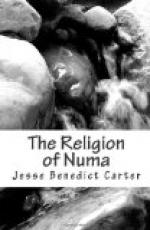The study of the outward and the inward effects of the Sibylline books is therefore the real history of religion in the first half of the republic. The outward effects are seen in the introduction of a series of Greek gods, who were in themselves in the main eminently respectable, and whose presence was in itself no offence to good morals, and if we stop there we fail to understand why the religious interest of the Second Punic War should change so quickly to the scepticism of the following century. The inward effects however, which, though they are hard to see, may yet be discovered between the lines of the chronicle, will explain all the undermining of foundation, until we wonder not why the structure collapsed so suddenly but how it managed to last so long.
The history of the activity of the books begins peaceably enough. In the year B.C. 496 Rome was in a bad way; her crops had failed and the importation of grain from Latium was rendered very difficult because of the war with the Latins in which she was engaged. In her distress she turned to the Sibylline books, and on the occasion of this their first recorded use, the oracles ordered the introduction into Rome of the cult of three Greek deities, Demeter, Dionysos, and Kore. It was a most appropriate and characteristic choice. In the first place the deities in question were worshipped at Cumae, the home of the books, whence Rome could, and probably did, borrow the cult; and in the second place Demeter was the goddess of grain, and it was from Cumae that Rome was already beginning to obtain her imported grain supply. Thus the coming of the Cumaean Demeter into the religious world of Rome is but the sacred parallel to the coming of Cumaean grain into the material world of Rome. The Greek goddess of grain came with the grain, just as Castor had come with the Greek cavalry, with this essential distinction however that Demeter came by the incantation of the books and the enactment of the Senate, whereas Castor’s coming was a slow and normal development.
It is important to notice closely exactly what happened when these deities were introduced, partly because they form the first recorded instance, and hence may well have acted as a model for subsequent repetitions of the act, but also because we have a more definite knowledge of the phenomena in this case than in many others. In the first place it is clear that the deities were felt to be foreign: not only was their temple built out the Aventine way, in the valley of the Circus Maximus, outside the pomerium,




